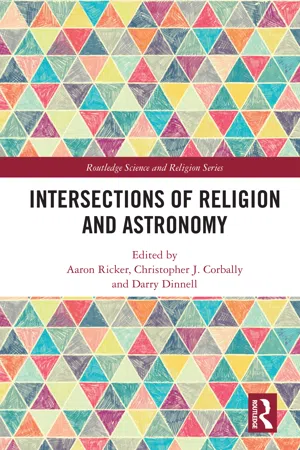
Intersections of Religion and Astronomy
- 232 pages
- English
- ePUB (mobile friendly)
- Available on iOS & Android
Intersections of Religion and Astronomy
About this book
This volume examines the way in which cultural ideas about "the heavens" shape religious ideas and are shaped by them in return. Our approaches to cosmology have a profound effect on the way in which we each deal with religious questions and participate in the imaginative work of public and private world-building.
Employing an interdisciplinary team of international scholars, each chapter shows how religion and cosmology interrelate and matter for real people. Historical and contemporary case studies are included to demonstrate the lived reality of a variety of faith traditions and their interactions with the cosmos. This breadth of scope allows readers to get a unique overview of how religion, science and our view of space have, and will continue to, impact our worldviews.
Offering a comprehensive exploration of humanity and its relationship with cosmology, this book will be an important reference for scholars of Religion and Science, Religion and Culture, Interreligious Dialogue and Theology, as well as those interested in Science and Culture and Public Education.
Frequently asked questions
- Essential is ideal for learners and professionals who enjoy exploring a wide range of subjects. Access the Essential Library with 800,000+ trusted titles and best-sellers across business, personal growth, and the humanities. Includes unlimited reading time and Standard Read Aloud voice.
- Complete: Perfect for advanced learners and researchers needing full, unrestricted access. Unlock 1.4M+ books across hundreds of subjects, including academic and specialized titles. The Complete Plan also includes advanced features like Premium Read Aloud and Research Assistant.
Please note we cannot support devices running on iOS 13 and Android 7 or earlier. Learn more about using the app.
Information
Part 1
Intersections of astronomy and religion
Ancient and post-ancient worlds
Notes
1 Religion and cosmology
Introduction
Cosmogony, anthropogony, and theogony
Myth, cosmology, and creation
Table of contents
- Cover
- Half Title
- Series
- Title
- Copyright
- Contents
- List of contributors
- General introduction
- Part 1 Intersections of astronomy and religion: ancient and post-ancient worlds
- Part 2 Intersections of astronomy and religion: enlightenment and scientific revolution
- Part 3 Intersections of astronomy and religion: the modern world
- Part 4 Intersections of astronomy and religion: future directions
- Index